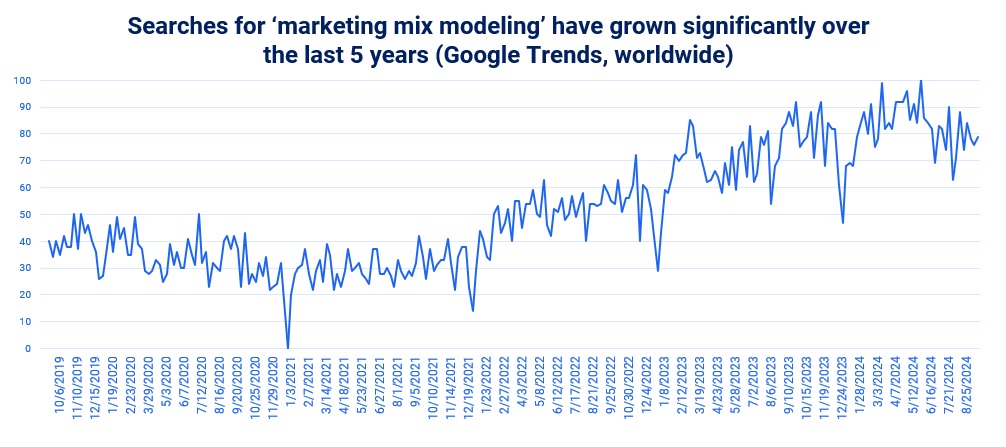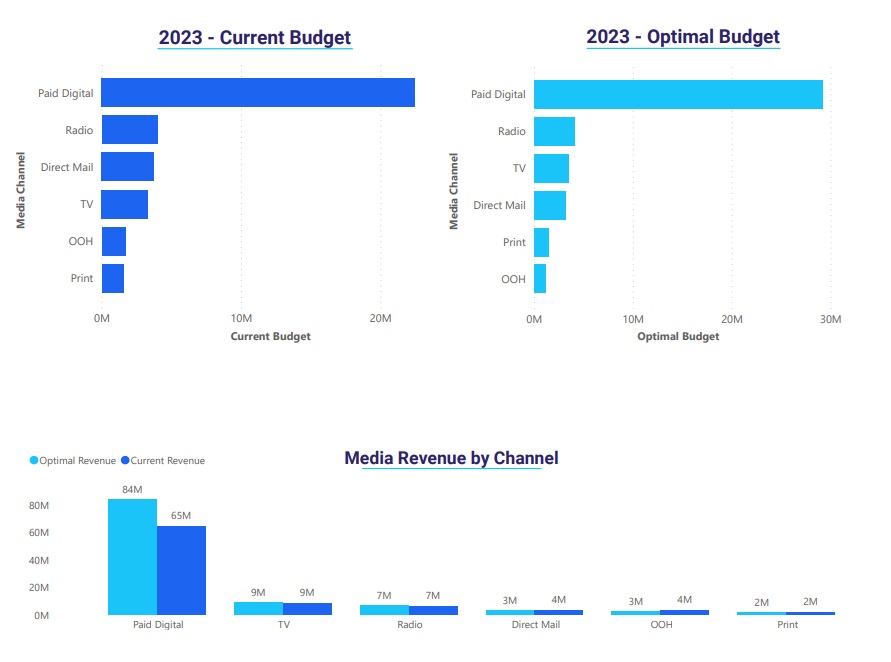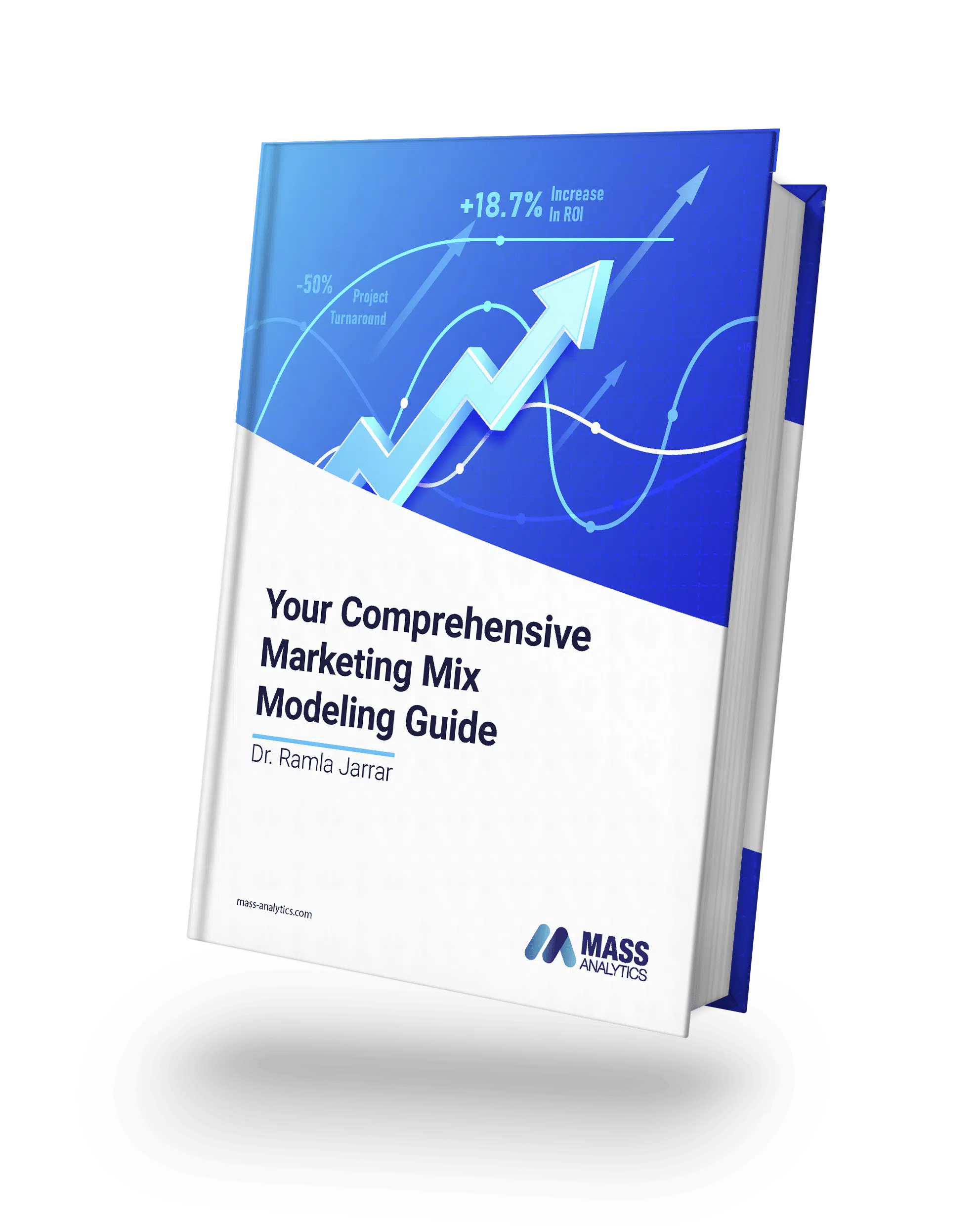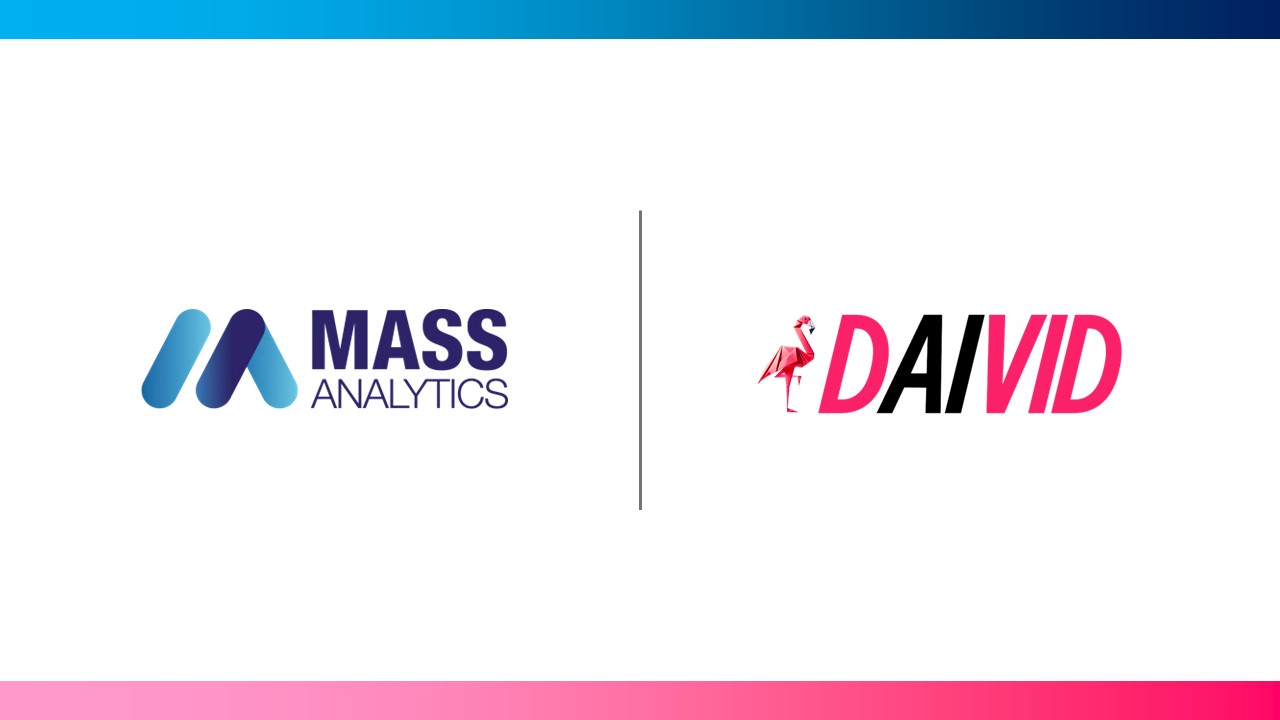Learn Marketing Mix Modeling: Data & Resources to Get Started
Marketing mix modeling (MMM) is seeing a renaissance.
In 2023, 60% of US advertisers reported that they were using MMM, and 58% of those not using it were considering doing so in the future, according to Kantar*. And it’s for good reason.
Similarly, a Deloitte study** found that C-Level leaders who placed high importance on marketing mix modeling were over 2 times more likely to exceed revenue goals by 10% or more.

No wonder then that companies are rushing to implement MMM. But what does MMM enable you to do? How can you implement it in your organization? Many vendors and consultants use the term to mean different things, and the technical nature of MMM can be confusing.
This guide, rooted in MASS Analytics’ expert approach to marketing mix modeling, is designed to answer that. It will provide you with a business understanding of MMM, its use cases, and how to implement it in your organization.
Let’s dive in.
What is Marketing Mix Modeling?
Marketing mix modeling is a statistical technique that helps marketers evaluate the effectiveness of their marketing efforts. It has 3 primary uses: measurement, budget optimization, and forecasting.
- Measurement: analyzing historical data to estimate how different marketing activities influence business outcomes, like sales.
- Optimization: optimizing the marketing budget allocation for maximum revenue based on ROI analysis.
- Forecasting: predicting sales & marketing performance based on historical results.
By considering various channels and accounting for external factors, MMM guides budget decisions and enhances overall media performance. Most importantly, it maintains privacy by not relying on individual user data or 3rd party cookies.
Marketing Mix Modeling Examples

Marketing mix modeling has a variety of use cases for businesses. The above is an example of optimization results brands can expect, but MMM can be used for so much more!
Here are some examples from different industries:
- A leading CPG brand wanted to understand the performance of various promotional mechanics to determine which one was most effective in terms of sales uplift. The MMM analysis revealed that while BOGOF (buy one get one free) promotions generated the highest sales uplift, shallower promotions like “25% off” were more profitable.Based on this, they decided to schedule promotions at least 6 weeks apart to avoid a significant loss in effectiveness.
- A B2B software company wanted to optimize their media budget across various countries and products. They built marketing mix models for 5 products across 8 countries. The insights gained enabled the company to make informed decisions on media investment, ensuring optimal allocation of their global budget to maximize sales. For instance, Paid Search significantly drove sales in the UK, while Email was a more important sales driver in Canada.
- A sportswear company faced the challenge of measuring the effectiveness of their omnichannel strategy across their sales channels. MMM uncovered the importance of their distribution in driving revenue as well as the strength of their brand image. By optimizing their media allocation, they achieved a 14% increase in media-driven revenue.
How Kellogg’s Optimized Media ROI & Budget Allocation
Ajay Ahuja describes the challenges Kellogg’s faced and how they were able to improve their marketing effectiveness with the support of MASS Analytics’ team and software. 👉🏻 Webinar: ROI Optimization & Media Allocation Based on MMM Models
Marketing Mix Modeling Compared to Different Approaches
Marketing mix modeling is not the only way to measure media effectiveness. Multi-touch attribution and experimental techniques are also valid approaches, though with different uses. Let’s see how they compare and explain how MMM fits among them.
Experiments
Randomized Controlled Trials, Lift Studies, or more commonly A/B tests, analyze the short-term effects of a specific marketing channel or campaign. Data may include campaign-specific metrics and results.
Usually, experiments can be performed through platforms like Google Ads. More advanced tests likely require a statistician or data scientist who can ensure the right experimental conditions.
Done right, experiments offer immediate insights into the incrementality of specific marketing activities. The main challenge, however, is that it’s hard to set up an experiment with proper statistical rigor. There are also issues with the replicability of results.
Multi-touch attribution
Multi-touch attribution (MTA) provides granular insights into the performance of individual touchpoints in the customer journey. It relies on user-level data like clicks and views to get an approximate idea of which channels a buyer interacts with and in which order.
MTA works best for refining tactical marketing execution. The performance of paid media platforms can be enhanced with insights from MTA analysis. For example, by improving targeting and creative selection.
Despite that, MTA suffers from a gigantic problem: the loss of 3rd party cookies.
Google is moving to block cookies on Chrome completely in the near future. Apple has already done it since 2021. And let’s not forget strict privacy regulations like the GDPR and CCPA under effect for years now.
Without 3rd party cookie tracking, MTA is missing touchpoints on critical customer journey steps. In many cases, it has no data at all. Because of this, the accuracy of MTA has become questionable at best and completely unreliable at worst.
Does this mean I shouldn’t use MTA? Not on its own. MTA can still be leveraged through triangulation of results from different approaches.
Triangulation: Combining The 3 Techniques
Triangulation is an approach that allows us to get a more precise read of channel effectiveness by leveraging results from multiple measurement techniques.
For example, say we want to optimize spend on Facebook Ads.
During our MMM analysis, we generate multiple response curves that give us different estimates of the channel’s incrementality. Which one should we choose?
One way to answer this question is by conducting a conversion lift study. The results we get will inform the shape of the curve.
Similarly, we notice that Facebook’s in-platform reporting, based on MTA touchpoints, indicates that the return on ad spend (ROAS) on Facebook is 560%. But our modeling results from MMM indicate it’s actually closer to 400%.
Guided by marketing mix modeling, experimental results, and Facebook’s own reporting, we can be reasonably confident in deciding what Facebook’s actual contribution is.
And it doesn’t have to stop there, as we get more data and see the sales outcome, we can calibrate the model further. We talk about this in detail in our ground truth article.
Marketing Mix Modeling Trends & Innovations
Marketing mix modeling has evolved dramatically over the recent years. So if you’re looking to adopt this methodology in your company, these are the top 3 innovations you should know about.
Automated Marketing Mix Modeling
What was once a very bespoke and manual mathematical exercise has been significantly automated. Every step of the marketing mix modeling process has been either sped up or automated.
Examples of this include bulk data transformation, automodeling, and rapid optimization of thousands of response curves.
However, some issues remain.
For instance, modeling still relies on the analyst’s assumptions. Some data sources still require significant manual cleanup, and new channels, with which the model is not familiar, require careful judgement.
While full automation has not been achieved yet, the industry is working towards that goal. Dr Ramla Jarrar spoke about this in detail during an episode of the Measure Up podcast:
In-House Modeling Software
From DIY open-source packages like Robyn to fully-featured software like MassTer, internal analytics teams now have plenty of options to run MMM on their own.
While not every company has the means or the interest to in-house, this new approach offers some advantages for the companies that adopt it.
For instance, it offers an extra layer of data security as there’s no transfer to an external provider. Then there’s the added bonus of minimal approvals from IT departments, which speeds things up.
In addition, the in-housing approach builds up a cost-effective marketing analytics capability, allowing teams to conduct a variety of analyses (for example: channel measurement, sales forecasts, and budget optimizations) at no extra cost to the company.
Measuring Long-Term Impact
Marketing has seen a marked shift from short-term, easily measured tactics to long-term investments like brand advertising and demand generation.
This was driven, in part, by landmark studies such as Binet & Field’s “The Long and The Short of It” as well as the lackluster results of direct ROI channels during the last few years, which has put their effectiveness into question.
In response, many companies have decided to invest in long-term initiatives to ride out the difficult economic situation and come out stronger by the end of it.
And what’s the best approach for long-term marketing measurement? Marketing mix modeling!
While MMM is able to measure impact over multiple years, not all models are designed for that purpose or have the data to support it. To explore this topic further, Meta has recently released a study in collaboration with academic and industry partners. They outline the different techniques that can be deployed for measuring marketing impact on a longer-term horizon, these include:
- 2-step modeling approach incorporating brand metrics with nested modeling.
- Measuring base sales and price sensitivity over time.
Marketing Mix Modeling Resources to Get Started
To build an MMM, you need 2 ingredients:
- Marketing & sales data
- Software to model it, extract insights, and optimize.
Let’s go through the many options available.
Marketing Mix Modeling Data
Company data: whether it’s for your own company or an external client, you should collect data on all their marketing activities, as well as factors that can impact it, ideally for the last 3 years. We talk about this in detail here:
What if I don’t have data? If you don’t have access to real data, fear not. There are several valuable community resources available to help you build MMMs:
- Conjura eCommerce Dataset: eCommerce analytics company Conjura recently made available an MMM dataset of close to 100 online brands. This valuable resource can be used to analyze the marketing spend for online-only purchases and digital channels.
- MMM Datasets curated by Forecastegy: A collection of real and simulated datasets for use in MMM. Credit goes to Mario Filho for discovering these.
- Bookworm Dataset: this dataset is used for the MMM project in our free Beginner’s Udemy course, you can follow the instructions or use it for your own analysis.
- Synthetic data: You can use packages like SiMMMulator or AMSS to generate marketing time series data that simulate the behavior of actual media channels. Both packages are well-documented in the academic literature.
Marketing Mix Modeling Software
Spreadsheet software: this is a great starting point for MMM analysis. Spreadsheets like Excel and Google Sheets are accessible and offer the necessary features for regression analysis. However, they do start to show their limits when conducting advanced analysis. For example, things like a limited number of rows and operations on large datasets become a hassle. Still, you can go a long way using spreadsheets.
Open-source MMM packages: new code libraries have been released making MMM more accessible. Meta’s Robyn has an active community, PyMC-Marketing also has good documentation and promising features, while Google’s Meridian introduces previously unavailable features to the open-source community, such as reach & frequency measures and search volume integration, enhancing model granularity and addressing endogeneity challenges.
The challenge of using these? You’re basically on your own if something doesn’t work. There’s also the issue of missing features.
Specialist MMM software: tools like MassTer are designed to cover the end-to-end marketing mix modeling workflow. Besides being fully featured for all MMM tasks, they also come with complete documentation, on-demand support, training hours, and consultancy. You basically get a whole team supporting you every step of the way.
Of course, that doesn’t come for free. As the developers of MassTer, we are biased, but we genuinely believe it’s the most cost-effective approach. We talk about this in-depth in this article.
Learning Resources
As the MMM community has grown, a lot of high-quality content has been created to help analysts and business leaders learn how to effectively leverage this powerful technique:
- Measure Up Podcast: hosted by Jim Gianoglio and Simon Poulton. Every episode is a fun exploration of the world of marketing measurement. Great guests and topics.
- MMM Masterclasses by MASS Analytics: hosted by Dr. Ramla Jarrar, this is the most comprehensive video course for MMM. Episodes cover every aspect of the marketing mix modeling workflow.
- MMM Hub Slack Community: the place to network and learn with fellow MMM enthusiasts. A lot of interesting threads, both technical and business.
Academic resources
Marketing mix modeling is based on econometrics, regression and time series analysis. If you are academically inclined and want to build solid foundations in these core areas, worry not, this field is full of luminaries. The following textbooks are focused on MMM:
- Market Response Models (Hanssens et al.)
- Handbook of Marketing Analytics (Hanssens et al.)
- Market Response and Marketing Mix Models (Bowman and Gatignon)
- Modeling Markets (Leeflang, Pauwels et al.)
And if you want to keep up with the latest research, we recommend you look into the Advertising Research Foundation (ARF) and Marketing Science Institute (MSI).
Sources
*Kantar, Measurement Solutions Research, US, 2023, N = 300 Brand, Full-Funnel & Performance Marketers, Feb 22 – March 24th 2023
**Google/Deloitte, Germany, India, U.K., U.S., Ads Measurement Market Research, online survey, n=870 senior marketing leaders and 111 C-Level leaders, Oct. 2022–Feb. 2023.
Written by Aziz Ben Hadj Yahia, Marketing Consultant at MASS Analytics.







